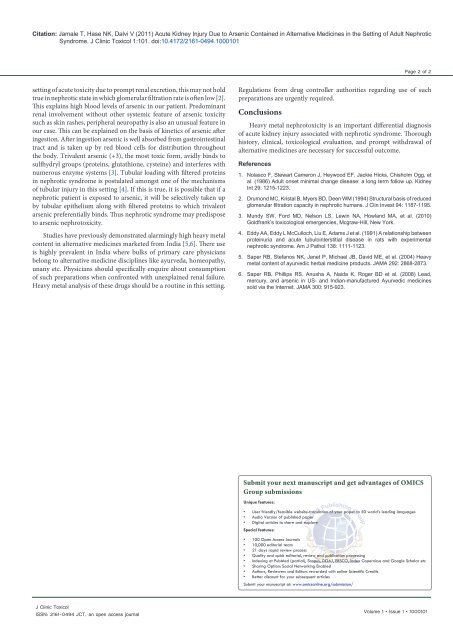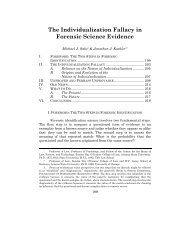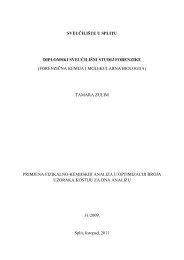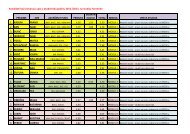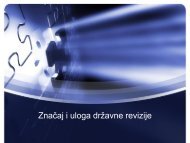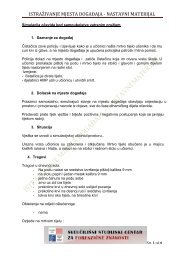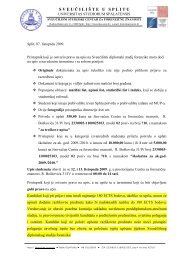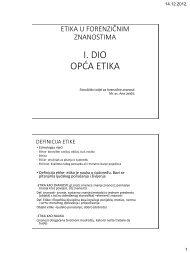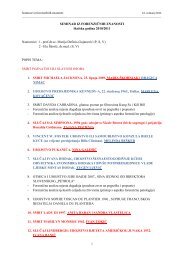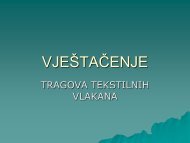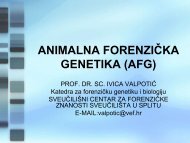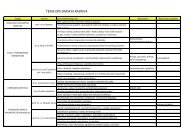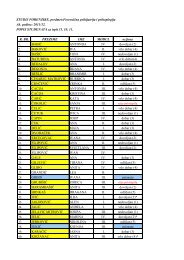<strong>Clinical</strong> <strong>Toxicology</strong>Research Case ReportArticleJamale et al. J Clinic Toxicol 2011, 1:1http://dx.doi.org/10.4172/2161-0494.1000101Open Open AccessAcute Kidney Injury Due to Arsenic Contained in Alternative Medicines inthe Setting <strong>of</strong> Adult Nephrotic SyndromeTukaram Jamale 1 *, Niwrutti K Hase 2 and Vikram Dalvi 31Asstt. Pr<strong>of</strong>essor, Dept <strong>of</strong> Nephrology Seth GS Medical College and KEM Hospital, Mumbai-12, India2Pr<strong>of</strong> and Head, Dept <strong>of</strong> Nephrology, Seth GS Medical College and KEM Hospital, Mumbai-12, India3Physician and Intensivist, Panji, GoaBackgroundPotentially toxic levels <strong>of</strong> heavy metals like lead, arsenic have been found in alternative medicines manufacturedin India. Given the widespread use <strong>of</strong> these preparations, their nephrotoxicity is likely to be common. Unexplainedrenal failure; therefore should always be evaluated for the possibility <strong>of</strong> heavy metal nephrotoxicity due to alternativedrugs. We report here a case <strong>of</strong> acute kidney injury that occurred in an adult with nephrotic syndrome which was theresult <strong>of</strong> arsenic nephrotoxicity following consumption <strong>of</strong> ayurvedic medicines.Case History33 year old male presented to us with history <strong>of</strong> puffiness <strong>of</strong>face, edema feet <strong>of</strong> 2-3 weeks duration. 4-5 days before admission hedeveloped oliguria with worsening <strong>of</strong> edema. There was no history<strong>of</strong> fever, upper respiratory tract symptoms, pyoderma, or jaundicepreceding the illness. He also denied any history <strong>of</strong> hematuria, flankpain, prior similar episodes or recent NSAIDs use. His past history wassignificant for use <strong>of</strong> unlabeled alternative ayurvedic powder and liquidfor eczematous skin lesions for last 6 months.On evaluation, he was afebrile, conscious, and alert with heartrate <strong>of</strong> 86 per minute, blood pressure 114/66 mmHg with nopostural drop. He had edema upto knees and there was no pallor,lymphadenopathy, skin hyperpigmentation, nail changes, or icterus.Chest was clear to auscultation, heart sounds were normal, there wasno hepatosplenomegaly. Higher mental functions were normal andthere was no evidence <strong>of</strong> peripheral neuropathy.Laborotary evaluation showed: Hemoglobin 13.4 g/dl, leucocytecount <strong>of</strong> 11300 (with 68% polymorphs and 22% lymphocytes), platelets2,33,100/cmm, Urine albumin 4+, no red blood cells, occasional puscells and granular casts. 24 hr urine protein 4.2 gm/day, blood ureanitrogen 16mg/dl, creatinine 1.6mg/dl, total protein 5.5 g, albumin2.4 g, sodium 132 mEq, potassium 3.8 mEq, chloride 101 mEq, serumtotal cholesterol 412 mg and triglyceride 344 mg/dl. Serologies forantinuclear antibodies and anti double stranded antibodies werenegative and complement C3 and C4 levels were normal. A kidneybiopsy was performed and in view <strong>of</strong> history <strong>of</strong> consumption <strong>of</strong>alternative medicines, samples <strong>of</strong> ayurvedic powder and liquid weresent for toxicological analysis.After admission patient remained oliguric and there was noresponse to volume expansion with 200 ml <strong>of</strong> 10% albumin withdiuretics. Serum creatinine rose to the peak <strong>of</strong> 3.7 mg/dl. Patient wastreated conservatively as a case <strong>of</strong> nephrotic syndrome with acutekidney injury. Renal replacement therapy was not required. After 8 days<strong>of</strong> oliguria patient went into diuretic phase and creatinine decreased to1.1 mg/dl on day 14 <strong>of</strong> admission.Kidney biopsy showed predominant involvement <strong>of</strong>tubulointerstitium with glomeruli showing normal basement membraneand cellularity. Tubule showed denudation <strong>of</strong> epithelium and fraying<strong>of</strong> borders. Interstitium showed deposition <strong>of</strong> pink, rectangular, andpolarizing crystals extending at places into the tubular epithelium andlumina along with sprinkling <strong>of</strong> lymphocytes. Immun<strong>of</strong>luroscence wasnegative for immune deposits. Electron microscopy showed diffusefoot process flattening consistent with minimal change disease.Toxicological analysis <strong>of</strong> alternative medicine showed very highcontent <strong>of</strong> arsenic-232 microgram (µg) per gram along with elevatedblood level <strong>of</strong> arsenic at 54 µg/dl (normal limit 0.17-5 µg/dl). Blood leadlevels were normal (10.2 µg/dl).Patient was treated with prednisolone 1 mg/kg/day (55mg/day), towhich he promptly responded and went into remission in 2 nd week <strong>of</strong>therapy. 4 years following the first episode patient suffered one relapse(steroid responsive) and is at present in complete remission.Given the clinical, laboratory, and histopathological findingspatientsuffered acute tubular necrosis with interstitial nephritis as aresult <strong>of</strong> crystallopathy due to arsenic contained in ayurvedic drugs.DiscussionAcute renal failure is more commonly seen in adult nephroticsyndrome and etiologies include hypovolemia causing prerenalazotemia (and if untreated acute tubular necrosis), drug inducedinterstitial nephritis, nephrosarca, bilateral renal vein thrombosis etc.[1,2]Although diuretics, NSAIDs, antibiotics are common causes <strong>of</strong>acute tubulointerstitial nephritis in this setting- alternative medicinesmarketed in India should be an important addition to this list. Theiruse is common and <strong>of</strong>ten not recognized as a cause <strong>of</strong> drug inducedrenal failure (ayurvedic preparations are commonly advertised as beingfree <strong>of</strong> side effects).To our knowledge, this is the first report <strong>of</strong> acute kidney injurycaused by alternative drugs in the setting <strong>of</strong> adult nephrotic syndrome.Although blood levels <strong>of</strong> arsenic are maintained normal even in the*Corresponding author: Tukaram Jamale, Asstt. Pr<strong>of</strong>essor, Dept <strong>of</strong> Nephrology,Seth GSMC & KEM Hospital Mumbai-12, India, E-mail: tukaramjamale@yahoo.co.inReceived June 14, 2011; Accepted July 07, 2011; Published July 10, 2011Citation: Jamale T, Hase NK, Dalvi V (2011) Acute Kidney Injury Due to ArsenicContained in Alternative Medicines in the Setting <strong>of</strong> Adult Nephrotic Syndrome. JClinic Toxicol 1:101. doi:10.4172/2161-0494.1000101Copyright: © 2011 Jamale T, et al. This is an open-access article distributed underthe terms <strong>of</strong> the Creative Commons Attribution License, which permits unrestricteduse, distribution, and reproduction in any medium, provided the original author andsource are credited.J Clinic ToxicolISSN: 2161-0494 JCT, an open access journalVolume 1 • Issue 1 • 1000101
Citation: Jamale T, Hase NK, Dalvi V (2011) Acute Kidney Injury Due to Arsenic Contained in Alternative Medicines in the Setting <strong>of</strong> Adult NephroticSyndrome. J Clinic Toxicol 1:101. doi:10.4172/2161-0494.1000101Page 2 <strong>of</strong> 2setting <strong>of</strong> acute toxicity due to prompt renal excretion, this may not holdtrue in nephrotic state in which glomerular filtration rate is <strong>of</strong>ten low [2].This explains high blood levels <strong>of</strong> arsenic in our patient. Predominantrenal involvement without other systemic feature <strong>of</strong> arsenic toxicitysuch as skin rashes, peripheral neuropathy is also an unusual feature inour case. This can be explained on the basis <strong>of</strong> kinetics <strong>of</strong> arsenic afteringestion. After ingestion arsenic is well absorbed from gastrointestinaltract and is taken up by red blood cells for distribution throughoutthe body. Trivalent arsenic (+3), the most toxic form, avidly binds tosulfhydryl groups (proteins, glutathione, cysteine) and interferes withnumerous enzyme systems [3]. Tubular loading with filtered proteinsin nephrotic syndrome is postulated amongst one <strong>of</strong> the mechanisms<strong>of</strong> tubular injury in this setting [4]. If this is true, it is possible that if anephrotic patient is exposed to arsenic, it will be selectively taken upby tubular epithelium along with filtered proteins to which trivalentarsenic preferentially binds. Thus nephrotic syndrome may predisposeto arsenic nephrotoxicity.Studies have previously demonstrated alarmingly high heavy metalcontent in alternative medicines marketed from India [5,6]. There useis highly prevalent in India where bulks <strong>of</strong> primary care physiciansbelong to alternative medicine disciplines like ayurveda, homeopathy,unany etc. Physicians should specifically enquire about consumption<strong>of</strong> such preparations when confronted with unexplained renal failure.Heavy metal analysis <strong>of</strong> these drugs should be a routine in this setting.Regulations from drug controller authorities regarding use <strong>of</strong> suchpreparations are urgently required.ConclusionsHeavy metal nephrotoxicity is an important differential diagnosis<strong>of</strong> acute kidney injury associated with nephrotic syndrome. Thoroughhistory, clinical, toxicological evaluation, and prompt withdrawal <strong>of</strong>alternative medicines are necessary for successful outcome.References1. Nolasco F, Stewart Cameron J, Heywood EF, Jackie Hicks, Chisholm Ogg, etal. (1986) Adult onset minimal change disease: a long term follow up. KidneyInt 29: 1215-1223.2. Drumond MC, Kristal B, Myers BD, Deen WM (1994) Structural basis <strong>of</strong> reducedglomerular filtration capacity in nephrotic humans. J Clin Invest 94: 1187-1195.3. Mundy SW, Ford MD, Nelson LS, Lewin NA, Howland MA, et al. (2010)Goldfrank’s toxicological emergencies, Mcgraw-Hill, New York.4. Eddy AA, Eddy L McCulloch, Liu E, Adams J et al. (1991) A relationship betweenproteinuria and acute tubulointerstitial disease in rats with experimentalnephrotic syndrome. Am J Pathol 138: 1111-1123.5. Saper RB, Stefanos NK, Janet P, Michael JB, David ME, et al. (2004) Heavymetal content <strong>of</strong> ayurvedic herbal medicine products. JAMA 292: 2868-2873.6. Saper RB, Phillips RS, Anusha A, Naida K, Roger BD et al. (2008) Lead,mercury, and arsenic in US- and Indian-manufactured Ayurvedic medicinessold via the Internet. JAMA 300: 915-923.Submit your next manuscript and get advantages <strong>of</strong> OMICSGroup submissionsUnique features:• User friendly/feasible website-translation <strong>of</strong> your paper to 50 world’s leading languages• Audio Version <strong>of</strong> published paper• Digital articles to share and exploreSpecial features:• 100 Open Access <strong>Journal</strong>s• 10,000 editorial team• 21 days rapid review process• Quality and quick editorial, review and publication processing• Indexing at PubMed (partial), Scopus, DOAJ, EBSCO, Index Copernicus and Google Scholar etc• Sharing Option: Social Networking Enabled• Authors, Reviewers and Editors rewarded with online Scientific Credits• Better discount for your subsequent articlesSubmit your manuscript at: www.omicsonline.org/submission/J Clinic ToxicolISSN: 2161-0494 JCT, an open access journalVolume 1 • Issue 1 • 1000101


